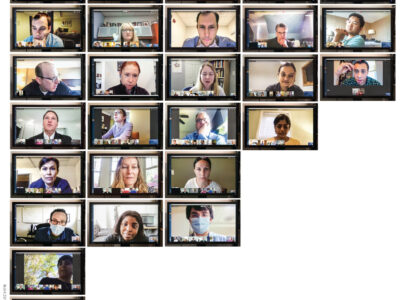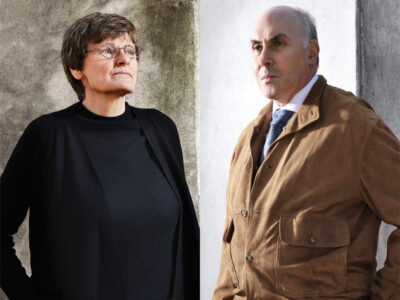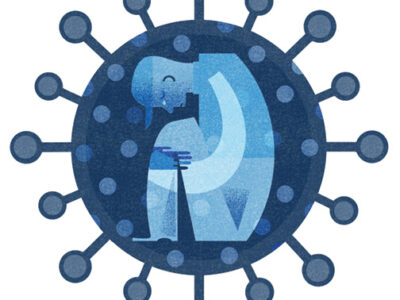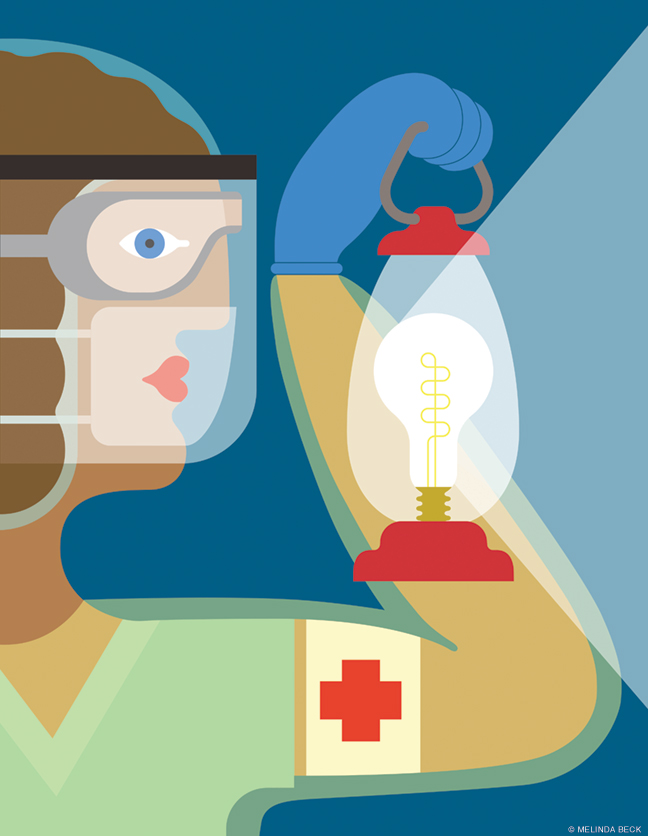
The past year has propelled America’s most trusted profession into the spotlight, with the World Health Organization’s designation of 2020 as the Year of the Nurse and Midwife followed by the unprecedented and continuing challenges posed by COVID-19. Penn Nursing alumni and faculty weigh in on coping with the pandemic and on nursing’s essential—and expanding—place in the healthcare system.
By JoAnn Greco | Illustration by Melinda Beck
Sidebar | Remote Possibilities
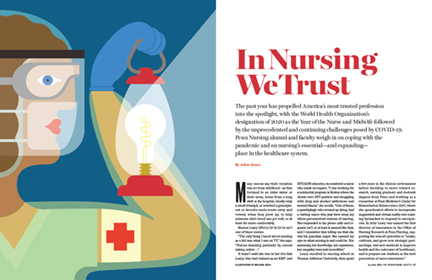
Many nurses say their vocation was set from childhood—as they listened to an older sister or their mom, home from a long shift at the hospital, tiredly relay a small triumph, or watched a grandparent or favorite uncle waste away and vowed, when they grew up, to help someone else’s loved one get well, or at least die more comfortably.
Marion Leary GNu’13 G’14 Gr’23 isn’t one of those nurses.
“The only thing I knew about nursing as a kid was what I saw on TV,” she says. “Nurses standing patiently by, nurses taking orders …”
It wasn’t until she was in her 20s that Leary, who had trained as an EMT and HIV/AIDS educator, encountered a nurse who made an impact. “I was working for a residential program in Boston where the clients were HIV-positive and struggling with drug and alcohol addictions and mental illness,” she recalls. “One of them, a quadriplegic who wound up dying, had a visiting nurse who just blew away my whole preconceived notions of nursing. She responded to his phone calls and requests 24/7, or at least it seemed like that, and I remember him telling me that she was his guardian angel. She opened my eyes to what nursing is and could be. Her autonomy, her knowledge, her experience, her empathy were just incredible.”
Leary enrolled in nursing school at Thomas Jefferson University, then spent a few years in the clinical environment before deciding to move toward research, earning master’s degrees and pursuing a doctorate while working as a researcher at Penn Medicine’s Center for Resuscitation Science since 2007, where she spearheaded efforts to incorporate augmented and virtual reality into training bystanders to respond to emergencies.In 2019 Leary was named the first director of innovation in the Office of Nursing Research at Penn Nursing, supporting the school’s priorities to “create, cultivate, and grow new strategic partnerships, test new methods to improve health and the outcomes of healthcare, and to prepare our students as the next generation of nurse innovators.”
One of her newest initiatives is Amplify Nursing, a podcast that spotlights nurses who are redefining the field.Chinelo Ofoma GNu’15, a traveling pediatric nurse practitioner, was a guest on the program. She has created an online platform, Nurse on Purpose, to question and dispel the media images—“the sexy nurse, the mute nurse, the battle-ax nurse”—that perpetuate stereotypes. Under its auspices, she recently presented a virtual training session on nursing tropes to journalists and nurses in her home country of Nigeria. “When I was a nursing student, people would always ask ‘You’re so smart, why don’t you want to be a doctor?’ I didn’t get it. I was surrounded by so many sharp and proactive nurses,” says Ofoma, with a hint of outrage. “Why aren’t we getting the voices we deserve? Nurses are earning PhDs, they are serving in Congress.”
The field’s diversification is “incredible,” says Regina Cunningham Gr’03, chief executive officer at the Hospital of the University of Pennsylvania (HUP) and assistant dean for clinical practice at Penn Nursing. “Nurses are everywhere. They’re in communities, schools, churches. They work in research, in pharmaceuticals, in corporations. Nurses create new roles for themselves all of the time. They identify needs and figure out how to meet them.”
A Big—and Continuing—Battle
Americans may not have a complete picture of all that nurses actually do, but that hasn’t stopped them from ranking the profession as the most trusted in the nation for nearly two decades running, according to an annual Gallup poll. Last year the World Health Organization (WHO) proclaimed 2020 as the International Year of the Nurse and Midwife, calling for increased investment in their education, jobs, and leadership training. The declaration was timed to the 200th anniversary of Florence Nightingale’s birth, but it was the arrival of the novel coronavirus pandemic that pushed nurses, along with other frontline workers, into the public spotlight, as they turned intensive care units into makeshift COVID-19 wards, wrestled with a dearth of personal protective equipment (PPE), and risked their lives to deliver care. “What nurses [have done] during the pandemic is just staggering—and they really got a lot of attention for it,” says Claire Fagin, the long-serving former dean of the School of Nursing (1977–1991) and interim Penn president (1993–1994) for whom the nursing education building is named. “We can’t let this moment pass,” she declares.
Nurses make up nearly half of the world’s healthcare workforce and they “spend more time with patients than anyone else in healthcare,” points out the school’s current leader, Antonia M. Villarruel GNu’82, who has been the Margaret Bond Simon Dean of Penn Nursing since 2014. “Often, they are the only provider in their area.”
Villarruel remembers encountering one such nurse on a research trip to Mexico. “She had created a needlepoint of the entire village, and was able to show me how many kids each family had, who had diabetes—it was this whole record-keeping effort,” she says. “Nurses take on incredible responsibilities like that all of the time and often they aren’t compensated adequately for it. Even in the United States, their salaries are stagnant after a period of time, the work is demanding, and burnout is common.”
In an opinion piece last September for the political news website The Hill, “As Nursing Goes, So Goes Public Health,” Villarruel and Fagin raised concerns about what nurses are dealing with during the pandemic and warned against nursing staff reductions at hospitals in the wake of expenses and losses related to COVID-19. “Nurses don’t abandon patients,” they wrote. “We must ensure that we do not abandon nurses.”
It’s happened before.
When the US entered World War I, nurses were sent overseas in droves, notes Julie Fairman Gr’92, the Nightingale Professor in Honor of Nursing Veterans at Penn and a specialist in nursing history. “So when the 1918 flu pandemic arrived, towns like Philadelphia were desperately calling for nurses, not physicians,” she says. (“If you would ask me the three things Philadelphia most needs to conquer the epidemic, I would tell you, ‘Nurses, more nurses, and yet more nurses,’” one local official reportedly declared.)
Once the war ended and the pandemic abated, “nursing leaders naturally expected that the public would back them as they strove to improve the status of the profession and to right working conditions,” Fairman adds. “But that never really happened—people have short memories. It was a big battle for nurses to make any headway, and those efforts continue to this day.”
One sticking point is the continuing requirement in some states that nurse practitioners (who along with nurse-midwives, nurse anesthetists, and clinical nurse specialists, are considered advanced practice registered nurses) enter into collaborative agreements with physicians before they can diagnose, treat, or prescribe medications. Such limitations have often been relaxed during the pandemic, but so far that’s just temporary. “These regulations are perplexing and unnecessary,” says Villarruel. “They can restrict nurses from practicing to their fullest.”
Empowering Education
Penn Nursing traces its origins to a training program within HUP that began in 1886. Eventually, a bachelor of science degree in nursing (BSN) was offered, first in the School of Education and then the Medical School, but it wasn’t until 1950 that a separate School of Nursing was established at Penn, followed in 1978 by the introduction of the first nursing doctorate at an Ivy League university. (While Penn Nursing remains the only Ivy to offer a BSN, more than half of its student body is enrolled in graduate programs.)
The school has produced two MacArthur Foundation “genius grant” winners: Ruth Watson Lubic HUP’55 Hon’85 in 1993, for her pioneering advocacy of the American nurse-midwifery movement, and Sarah Hope Kagan, the Lucy Walker Honorary Term Professor of Gerontological Nursing, who was honored for her research on older cancer patients 10 years later [“Sarah Kagan’s ‘Genius Idea,’” Nov|Dec 2004]. For five consecutive years, Penn has been named the world’s top nursing school by QS World University Rankings, an international ranking service; its master’s degree program is tied for third place among nursing schools on 2021’s US News & World Report list; and it has received more research funding ($11.3 million) from the National Institutes of Health than any other nursing school for three years running.
“Penn Nursing is extremely empowering of its students. It pushed us to reach our greatest potential,” says Flannery Farrell Nu’15 GNu’19, a licensed midwife. “I never really had an understanding of how powerful nurses can be and how crucial they are to making our healthcare system work until I came to the school.” The extensive contact nurses have with patients means that “we can have the honest conversations with them and find out what they really want,” she adds. “We are trained to be their advocates.”
Farrell thinks the curriculum prepared her as well as possible for the onslaught of the pandemic (a mass casualty simulation covers some of the same ground, albeit on a smaller scale and shorter time frame), but she says she would have liked more frank discussions on issues like anti-racism. “I think today’s nursing students are demanding that as they try to work very hard to effect change,” she says.
Villarruel, who grew up in a Mexican-American household, recognizes the concern firsthand. During her own college and graduate school years, she says, she rarely ran into Latinx instructors or students. (Overall, the nursing workforce in the US is about three-quarters white.) These days, underrepresented minorities account for 17 percent of Penn Nursing’s students. And while social justice and health inequity figure in the nursing curriculum, Villarruel adds that Penn Nursing is “committed to increasing its diversity.”
A recent $2 million gift from Penn President Amy Gutmann and her husband Michael Doyle will fund 10 “leadership scholars” annually among undergraduate and graduate nursing students, chosen for diversity, first-generation status, academic achievement and leadership potential, and interest in working with underserved urban and rural communities.
Beyond the Bedside
Recent graduate Alaina Hall Nu’18 understands that working with minority populations, whether in urban centers or rural villages, will become an increasing part of healthcare’s future. A recipient of the 2018 President’s Engagement Prize [“Gazetteer,” Jul|Aug 2018], a University-wide competition that provides up to $100,000 in funding and a $50,000 stipend for seniors to design and undertake impactful post-graduation projects, her path has led to a deeper involvement with at-risk populations. Hall says she has a “passion for working with communities that are impoverished.”
She used her grant money to return to an orphanage in Mexico where she had been volunteering since high school, with a goal of reducing pediatric infections like stomach bugs and upper respiratory illness. Her year-long project involved repairs to the town’s sewage system and building a new water filtration system for the orphanage, as well as health education components. “I think it made me a better nurse,” Hall says. “I’m more prepared for leadership roles. I’m more adaptable.”
After returning to the US, Hall joined the pediatric intensive care unit at Montefiore Medical Center in the Bronx. There she underwent a trial by fire as the borough’s largest hospital was bombarded with COVID patients just a few months after she came on board. “The experience made me realize that being a nurse goes beyond making sure patients are out of pain. It means working to build a society that will protect people from being wiped out by crisis,” says Hall, who is currently pursuing an online master’s degree in humanitarian action, with an eye toward working for WHO or UNICEF.
Hall says she was inspired by her grandmother, a nurse who volunteered at free community clinics during her time off. Patti Brennan GNu’79, too, started out with what she calls a “classic 1960s dream,” she says: “My mom was a nurse, so I was going to be a nurse.”
But her early experiences with computer simulations at Penn led to an interest in harnessing the power of data to support nurses in making the best choices for improved patient outcomes—ultimately leading to her appointment as the first nurse to head the National Library of Medicine (NLM), the world’s largest biomedical library.
Nursing’s history of quantitative reasoning actually starts with Florence Nightingale, Brennan says. “Most of her advances came about because of her observations and the data she mined,” she explains. “We attribute a nurse’s success to intuition, which is often true, but we are also skilled in watching, and smelling, and touching—that’s all data.”
Whether they choose to burrow into communities, or data, or something else, nurses are increasingly thinking beyond the bedside—and pursuing advanced degrees to get the preparation they need. According to the website 2020nurseandmidwife.org, established to mark WHO’s Year of the Nurse and Midwife, as of 2019 the percentage of America’s approximately four million nurses who hold a BSN or higher was about 63 percent. Those degrees have brought opportunities for more nurses to specialize in specific areas of medicine like psychiatry or geriatrics; move into entrepreneurial disciplines such as nurse navigators and nurse practitioners; and teach, research, and advocate both for patients and the profession itself—and opened new paths for nurses to become leaders.
Regina Cunningham also hails from a healthcare family and began her nursing career by pursuing an early interest in oncology at Memorial Sloan Kettering Cancer Center in New York. There she was exposed to healthcare’s administrative side and a desire to better understand the relationship between nurses’ working circumstances and patient outcomes, which eventually led her to a PhD at Penn; leadership roles at the Abramson Cancer Center; and positions as chief nursing executive for the Penn Health System and, currently, as HUP’s chief executive.
“Most hospitals are run by people with backgrounds in healthcare administration or finance,” Cunningham says. “A long time ago, practitioners running hospitals were a lot more common—Nightingale ran her hospitals. It gives you an incredible amount of credibility when you understand the obstacles and pressures that physicians and nurses face.”
As the pandemic’s first wave hit last spring, that trust and insight became paramount. Cunningham and her executive team knew they had to protect their staff even as the patient census climbed every day and supply chain issues and price gouging brought other problems. “I wanted to do this work to influence the practice environment,” she says. “The development of new policies and the decisions on how resources are allocated are huge and ultimately affect the patient.”
Cunningham is part of an ad hoc committee of the National Academies of Sciences, Engineering, and Medicine that will produce a report, The Future of Nursing 2020–2030, scheduled for release early in 2021. An earlier report covering the 2010–2020 decade called for the removal of regulatory obstacles and advocated for the granting of increased graduate degrees. This time the focus will be on the “roles that nurses can and should play in driving health outcomes in a positive way,” Cunningham says. “It talks about the potential for nurses to move the needle on health equity, about the importance of wellness among nurses themselves, and the lessons from COVID. It’s got some strong recommendations on advancing the impact of the field.”
Nursing While Male
Across campus at Penn Presbyterian Medical Center, James Ballinghoff GrN’19, the facility’s chief nursing officer and associate executive director, also spends his days advocating for nurses. Staffing—or lack of it—was his top concern when COVID-19 hit. “We knew that if we got hit in the same way [as New York], we wouldn’t have nearly the number of nurses we needed in critical care,” he says. “We had to evaluate and develop new models of care very quickly and do it on our feet because this was all relatively new and we weren’t sure how infectious it was and how many patients we’d see admitted.”
Though he’s an administrator now, Ballinghoff says he continues to miss bedside nursing. He originally came to the profession somewhat by chance, having held various jobs in the service industry, waitering and working for Atlantic City casinos after high school. “I was always interested in science so when I met a male nurse, I was intrigued,” he says. “I got to know more about the exciting opportunities and I took my first class and I was hooked. I tell people all the time that it’s one of the best areas you can get into. You find your niche and you find your strength and you can do anything.”
Although nursing is one of the fastest-growing fields in the US—with more than 175,000 annual job openings projected for registered nurses through 2029, according to the Bureau of Labor Statistics—not many men are hearing this message. Less than 10 percent of nurses are men, which initially came as a surprise to Marcus Henderson Nu’17 GNu’20. “When I applied to nursing school, I didn’t think anything of it,” he says. “Then when I got there, I saw that I was one of just eight men. I couldn’t help but notice the gender division. Some of my classmates were even teasing that men couldn’t be nurturing. I was, like, ‘So I wasn’t nurturing when I wiped my great-grandmother when she soiled herself?’”
The first in his family to go to college, Henderson is another President’s Engagement Prize winner, awarded in 2017 for his project with classmate Ian McCurry Nu’17 to work with a Philadelphia homeless shelter on increasing access for its underserved population [“Gazetteer,” May|Jun 2017]. He is also serving on the committee working on The Future of Nursing 2020–2030 report, having been selected, like Cunningham, in a national search.
“Decisions that impact the healthcare of people are put into place all of the time and nurses aren’t part of the discussion,” Henderson says. “And it’s not just about insurance, or Medicaid. I’m talking about how transportation works, how housing authorities work, how the Department of Agriculture handles food access. Nurses can provide a vital perspective on how these policies affect the communities they serve.”
Henderson anticipates he’ll ultimately pursue an academic career, along with possible government service. “I often joke,” he says, sounding dead serious, “that I’d like to be the first nurse to become Secretary of Health and Human Services.”
Healthcare Startup
In contrast to the 90 percent of her Penn Nursing peers who opt to move on to a master’s degree program, Sarah Gray Nu’13 was eager to enter the job market. Once she started looking around, though, she was “shocked at how difficult it was to figure out my options. It was all so overwhelming.”
After her husband received an offer to work in San Francisco and the couple relocated, Gray settled into a career as a pediatric nurse but discovered that “I was more drawn to the processes, the inefficiencies, the lack of resources,” she says. “I had friends working for Facebook and Apple and Google that were surrounded by innovation and their employee experience was so robust, autonomous, and flexible. I thought, why does healthcare seem so behind? I wanted to be part of that change, that sense of being on the cutting edge.”
Gray began exploring healthcare startups that appealed to her desire to shake things up. When she stumbled on something called Trusted Health, she thought she’d found what she was looking for. “It was basically still a concept [about creating a job marketplace for nurses],” she says. “But it looked like they were trying to build exactly what I had wanted as a nurse.” She started pitching in and before long the two founding partners invited her to join them as a founding clinician and the platform’s first non-tech hire.
Trusted Health’s timing has been ideal—on track to meet a predicted hiring boom designed to serve an aging population with increased healthcare needs and a concurrent surge in nurse retirements (nearly half are already over 50). Now with more than 200,000 nurses on its platform, the company specializes in travel, or contract, nursing. “Many nurses aren’t interested in arriving on a floor and staying there for the next 20 years,” Gray observes.
As COVID spiked around the nation, Trusted Health found itself well-positioned to send hundreds of temporary nurses from hotspot to hotspot, along the way creating a newly specialized workforce. “It’s been exciting for me to work for a company that is itself a model of how nurses can be utilized,” Gray says. “About 20 percent of our employees are RNs, and they’re on the tech team, in marketing, in compliance. I realize that nursing has a jam-packed curriculum, but I would challenge Penn Nursing and all nursing schools to find a way to set their students up for careers that break the boundary of the clinical setting. When nurses take control of their careers, they can find growth and challenges in dozens of non-traditional ways.”
Villarruel has watched the change firsthand. “My parents channeled me into nursing because they wanted to make sure I would always have a job,” she observes. “They would be absolutely amazed at just what kind of opportunities await today’s nurses. There are so many paths which can be charted, but still it’s the basics of the experience—the science, the empathy, the critical thinking—that can prepare you for anything.”
“Heart” and “Head”
Despite promising vaccine news, the fall surge in COVID-19 cases across the nation—which could worsen throughout the winter—is a reminder that the pandemic is still very much with us. And nurses will make “extensive and expansive contributions” to weathering this latest onslaught, both in “what we do and how we lead,” says Villarruel. “People understand and know the ‘heart’ of nursing, but they don’t think about the ‘head,’ and what a powerful combination nurses have in both.”
As hospitals—and healthcare workers—are once again being stretched near the breaking point, there have been calls for strikes over working conditions and inadequate PPE, and many messages from health workers on social media imploring the public to wear masks and practice social distancing.
“The pandemic has brought to light the true conditions in which our frontline workers are forced to engage—for the benefit of others,” says Villarruel. “That is what strikes are about; it is not about nurses per se, but about advocating for environments that will keep people—healthcare providers, patients, families—safe.”
Villarruel would like to see public expressions of gratitude translate into “meaningful investments in nursing education; to developing a true career trajectory into the profession; to integration of nurses in policy decisions—whether at the institutional or global level.”
That’s “a big ask,” she admits. “But we have already made so many adjustments—out of necessity—and we need to continue to move forward.”
SIDEBAR
Remote Possibilities
Penn Nursing has quickly adapted its teaching following the campus lockdown last spring and during this year’s virtual fall semester. This included not only remote classroom learning but virtual clinical experiences at the graduate and undergraduate levels.
To allocate for missed clinical time and due to quarantining, the school created new virtual simulations and recorded them, as well as converted more than 20 existing simulations to an online platform. It also expanded the square footage devoted to its simulation center into unused classroom space to accommodate social distancing regulations. Students were also able to take advantage of some unique learning opportunities presented by the circumstances: undergraduates participated in on-campus COVID testing, for example, while several nurse practitioner candidates volunteered for the Moderna vaccine trials.
Although some students are scheduled to be back on campus for the spring semester starting January 20 [“Gazetteer,” this issue], a large part of clinical training will continue to be done through remote and socially distanced in-person simulations “due to space restrictions and ratios, unit availability, and competing schools for clinical placement,” says Penn Nursing dean Antonia Villarruel.
Psychiatric and community simulations in particular lend themselves very well to the remote platform, Villarruel adds. She also notes that telehealth training and virtual reality offerings will increasingly make their way into teaching during the upcoming semester and likely find a permanent place in the curriculum. —JG
JoAnn Greco writes frequently for the Gazette.


